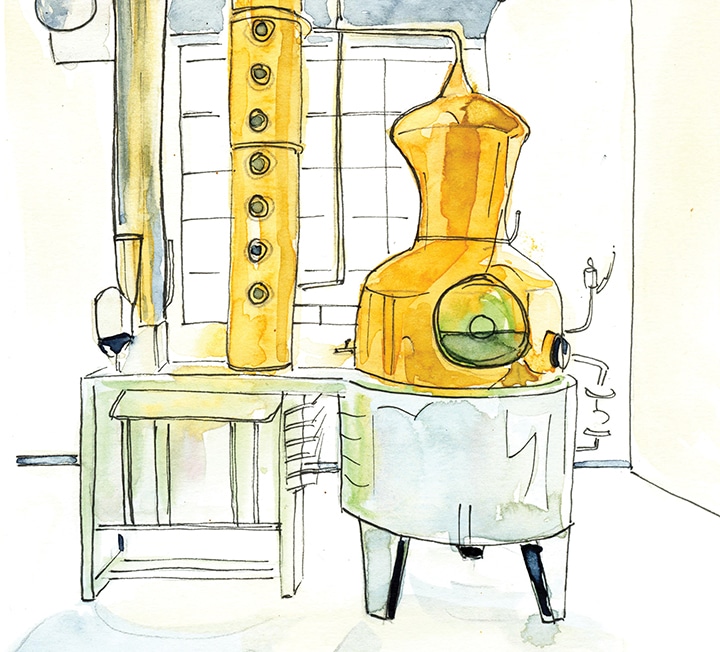Tools of the trade: the copper gin still
Tom Hills of East London Liquor Company on one of the essential tools of his business


“THE WHOLE PROCESS TAKES SIX OR SEVEN HOURS AND, PROVIDED EVERYTHING HAS GONE TO PLAN, THAT’S IT”
Interview & illustration: Ed Smith
I’ve been the head distiller at East London Liquor Company since we were founded five years ago. We have a range of three different gins: our signature, everyday house gin, and then two premium ones. We also produce vodka and, since 2015, whisky, which is rare in London – ours was the first whisky to be made in London in over a century.
Spirits are made through the distillation of alcohol and water, for which you need a still. We have four stills: one we use for gins and vodka; two are for the whisky process; and the fourth is a smaller one that we use in an R&D lab set-up. To keep things clear, I’ll focus here on the process of making gin.
Distillation is the separation of two different liquids with differing boiling points. Water boils at 100C. Pure ethanol, on the other hand, boils at about 78C. The basic premise goes that if you heat a mixture of alcohol and water to above 78C but below 100C, the alcohol will boil off and condense elsewhere, while the water stays behind. Because the flavour compounds in botanicals are soluble in alcohol but not water, they are carried in the alcohol vapour and, once condensed, they flavour the spirit.
For gin we start with a strong, near-pure alcohol, add water and botanicals, and then begin distilling. What we end up with is a concentrated gin – the distillate – which is about 82-83% ABV. We then add ‘reverse osmosis’ filtered water to bring the spirit to bottling strength (45-47%). The whole process takes six or seven hours and, provided everything has gone to plan, that’s it. After a short period of resting, the gin can be sold. We use the still twice a day, producing about 600 bottles of gin at a time.
Our gin still is made by Holstein, a German company. If we’re getting technical, it’s a ‘hybrid pot-column still’. The ‘pot’ element is essentially a 450-litre kettle, which is heated by a steam jacket. The ‘column’ allows us to control how concentrated the spirit is when we collect it as it condenses. The still is made from copper. Aside from looking great and being a good conductor of heat, the main benefit is that unwanted bi-products of fermentation such as sulphites and sulphates, which have a negative effect on flavour, react with the copper to leave a greenish-bluish-black compound on the inside of the still. This shows that the impurities have been left behind and we get a cleaner, better-tasting gin as a result.


